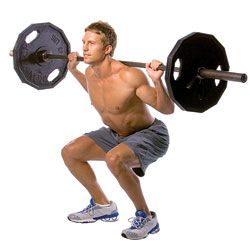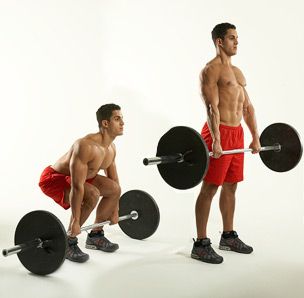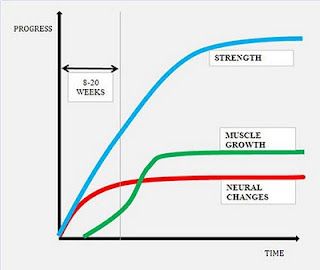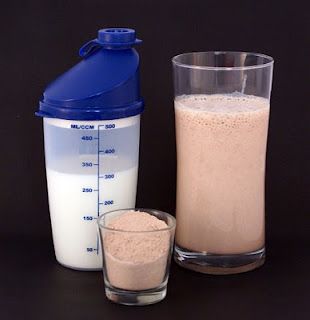How to build muscle
So you have decided that you want to get in shape. You've started eating healthy, embarked on a new cardio program, and have gotten yourself a crazy expensive gym membership and a new pair of workout shorts that make your legs look fantastic. You drape your sweat towel over your shoulder and walk into the weight room with the determination of a hard and effective workout. Now what? Where do you start? Do you go to the free weights section, wait for that sweaty, red faced beefcake to stop grunting and get off the bench press, or do you head for the machine that looks the easiest to master and one you not going to look like a total idiot trying to figure out how to use?
There are so many choices you can make when you walk into the weights area of the gym. Some choices are more beneficial to your muscle building efforts than others. Here I look at some of the research and recommendations by some of the fitness industry's top experts on how to effectively build muscle, and tips and training methods that I use in the gym that have worked for me.
A little disclaimer before I start. As with all my posts on this site, let me reiterate that I am not a personal trainer, nutritionist, or health expert and any information that I put on my blog is information that I have researched from reliable sources, or things I have found that have been personally beneficial in my fitness goals. I would recommend that anyone who is embarking on a weight training routine first consult a qualified personal trainer before attempting to lift any weights, or otherwise you may injure yourself. With anything, every individual is different and what may benefit myself and some people, may not benefit others.
Compound Exercises
If you are wanting to build muscle and lose fat, it is very well known in the fitness industry that you need to stop wasting your time and energy on isolation exercises and start doing compound exercises.
Compound exercises are movements that go through more than one joint or require you to use more than one muscle group to lift the weight. They stimulate more muscle fibers and as a result build more muscle. Isolation exercises are great once you have already built muscle and strength, but until then stick with the larger movement exercises. Examples of compound exercises are squats, deadlifts, chin ups, bench press and shoulder press
Lift Heavy Weights
If you want to build muscle, then you need to get stronger. Strength equals muscle. There is great debate in the bodybuilding community still even to this day as to what the optimal amount of reps and sets are to gain muscle, but one thing they all agree on is that you need to overload your muscles with substantial weight to force them to grow. Gone are the days where large amounts of light weights at high repetitions are recommended as the best approach to build muscle.
Recent research shows that heavy weights in the rep range of 6 - 8 reps stimulates muscle growth and this is typically the rep range I aim for in my workouts. How do you judge how heavy you should be lifting? Well they say that if you can easily lift the weight more than 8 reps, then you need to increase the resistance.
Full Body Workouts
Free Weights vs. Machines
With so many options on the gym floor, which ones do you choose? Well they both have their benefits however free weights may just have the advantage over machines and exercise equipment. Free weights allow you to lift the weight through the full range of movement, rather than a predetermined range such as that of machines, causing you to use stabilizer muscles and prevent any imbalances or weaknesses in muscle groups. When lifting with a shoulder press machine for example, if your right shoulder is stronger than the left, than it will lift the majority of the weight causing an imbalance between the two. Free weights encourage both sides to lift the same amount of weight because each shoulder operates independently from each other. They also engage all of your muscle fibers throughout the entire movement encouraging bigger muscle gains.
The disadvantage of using free weights is that if you do not know how to lift the weight properly, there is an increased change of injury, so make sure you get some advice on proper form before you go trying to pump out some reps.Muscle Confusion
In consideration of the above mentioned points, no matter what exercise routine you prefer and benefit from, how heavy your weights, or what machines you use, if you stick to the same routine week in week out, then you are bound to plateau. The key to muscle growth is muscle confusion.
Our bodies have a crazy ability to adapt to whatever situation we put them in, and they will gradually adapt to your workout also. So when you first hit the gym you will see initial results with your fat loss and increased muscle size, but as your body adapts to what you are throwing at it, your results will subside and you will discover that the 30 minutes on the treadmill and 30 minutes of weight training just aren't doing what they used to. So, confuse you muscles and confuse your body.
Mix things up. Increase or decrease your reps or sets, try different machines or exercises, change the type of cardio you are doing and what time of day you are doing it, and change up the time speed of which you lift weights (do you lift fast up and slowly down, or visa versa?) or try throwing in some drop sets. It will break you out of that plateau and keep you interested.
Eat More
You want big muscles, you gotta eat. A lot. No amount of salad munching is going to get you to explode to the size of those guys you see on the cover of muscle building magazines. That's right, your muscles need fuel to grow and they get that from calories.
Fitness experts say that muscle growth is 80% nutrition and 20% weight training, meaning that if your diet is not where it should be, no amount of countless hours and training at the gym by you is going to force your muscles to grow. You need a calorie surplus to provide your muscles with enough protein, carbohydrates and fats they need to repair themselves after a workout. If you are on a diet and have reduced your calories in an effort to shed some fat, it may be effective in reducing your love handles but it won't grow your biceps.
But before you go running down McDonalds to inhale a Big Mac, your food needs to be whole, clean and nutritious, not junk food or fast food, otherwise while your muscles may grow but so will that muffin top.
Your muscles also need energy and your body's preferred source for energy is carbohydrates, so If you are on a low carb diet, or are carb-o-phobic, then you may want to increase your carb intake, preferably in your post workout meal / shake.
Post Workout Nutrition
My readers know the obsession I have with peanut butter, and this is one of the times of the day where I allow myself to scoff it down with little to know thought on calories or fat. Now personally I love my breakfast and think it is the most important meal of the day, however fitness experts argue that the meal (or beverage) you consume after a workout is far more important and will determine how much your muscles will grow.
When you weight train, you breakdown muscle fibers and you deplete your cells of glycogen, so a meal high is protein to repair the muscle and carbohydrates to replenish that glycogen is recommended. Now I never recommend protein shakes and meal replacements over whole foods, your body prefers whole foods and in turn burns more calories in it's digestion than when you consume the equivalent in a shake or beverage. However this is the one meal or part of the day where a shake is ideal. It provides your muscles with nutrients faster than whole foods because they are broken down and absorbed at a rapid rate by your body.
There are conflicting views by experts as to what the ideal protein to carbohydrate ratio is, and how quickly you need to consume it after working out to see maximum benefits, but if you grab a protein shake with both and chug it down within 40 minutes of your last set, you should be fine.
Cardio
If you want to build bigger muscles, then you may need to pull back on the amount of cardio you are doing. Sure, those long runs you do for miles and miles may be helping with your fat loss, but it will be taking calories away from your muscles, which they need to grow.
Lets take a look at two very different athletes and compare body structure. A marathon runner has a very lean thin frame, ideal for running long distances, and this is gained from the large amounts of cardio they do. A sprinter on the other hand, who completes short, rapid bursts of intermittent cardio, has a more muscular body. Both body types are fine, it just depends on your goals and which type you prefer.
How much cardio is too much? That is a bit of a grey area. Personally, I used to do cardio first thing in the morning on an empty stomach because it has been reported to be 300% more effective in weight loss than cardio than night for example. I would only do half an hour, and it was very effective in dropping fat, but I found that I became too skinny because my muscles didn't have enough calories to grow and hence no matter how much weight I was lifting I wasn't getting any bigger.
When you do cardio, some muscle proteins are broken down and used as energy. If gaining muscle is your goal, then stick to roughly 3 cardio sessions per week, at around 20 - 30 minutes per session, preferably on days when you are not lifting weights.
Rest
This is a lesson I have known about for a long time, but only just really implemented and benefited from. We all think that to get bigger muscles, we need to spend crazy amounts of time lifting weights every day. The more you workout, the more the benefit right? Not true. You see, your muscles do not grow when you are in the gym. When you lift weights you are tearing and breaking down your muscles, but they repair and grow that night while you are sleeping and the following day whist you are resting.
Let me put it this way; your muscles are like houses and buildings, when you lift weights it's like there is an earthquake and all the houses and buildings break down and collapse. After the earthquake you need to rebuild the houses and make them stronger than before, but if another earthquake comes the following day before you have rebuilt, then the houses are never fully repaired. So give your muscles ample time to repair and grow before you head back to the gym to tear them apart again.
How much rest is needed? Well fitness experts say it all depends on how long you have been training for. People new to weight lifting will find that their bodies don't require as much time to recover, where as intermediate and advanced lifters will need to give their muscles larger amounts of rest for maximum growth. They recommend at least 24 hours in between lifting weights. Try a day in between routines at first, see how it works for you, if you are not happy with your growth then try two days. Experiment with it.
As with anything, its all about the effort you put into it. If you want to build muscle then it takes a lot of time and energy to making sure you are doing everything right and giving your body everything it needs to put it in an anabolic state of muscle growth. As mentioned above, everyone is different, and what works for one person may not work for another. Listen to your body, change things up, and don't be afraid to experiment with different approaches. Just make sure you get some advice from a personal trainer of exercise expert before embarking on a muscle building routine.
Source: http://www.thehealthyboy.com
Пријавите се да бисте објавили нови коментар

